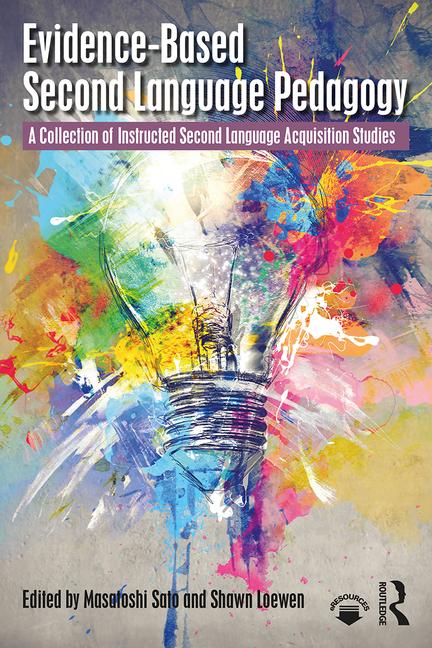A collection of instructed second language acquisition studies

Masatoshi Sato & Shawn Loewen (Eds.)
New York, NY: Routledge
358 pages
ISBN-10: 0815392532
ISBN-13: 978-0815392538
Instructed second language acquisition (ISLA) is a “subdiscipline of second language acquisition” state the editors, Sato and Loewen, in the first chapter titled Toward Evidence-Based Second Language Pedagogy: Research Proposals and Pedagogical Recommendations. Their aim is to present research studies whose findings are relatively easy to transfer into classroom settings, and for this to happen, they systematically and unwaveringly emphasize the pedagogical implications of the papers, which focus on instruction, the learning process and its outcomes as well as learner and teacher psychology.
After providing an overview of the learning theories that have a direct relevance for second language (L2) instruction, Sato and Loewen set the scene by looking at the most widely used instructional frameworks and learning processes that may facilitate L2 learning, since the discipline’s aim is “to examine pedagogical interventions that help learners develop L2 skills more efficiently and effectively” (p. 1). In order to do this, they look at aspects that can be “instructionally manipulated” (p. 7), such as attention and awareness, metacognition, and engagement. They also dwell on learner and teacher psychology including teacher well-being (the latter a relatively new field of investigation) and make sure that they summarize the further research proposals and pedagogical recommendations as they introduce and situate the studies that follow.
Sato and Loewen highlight the need for a dialogue between teachers and researchers and duly present the latest round of debate (Medgyes, 2017; Paran 2017) about the value of research for classroom practitioners. They recall that even though teachers often do not have the time and resources to access research, they do have an interest in it, especially as they feel that research findings may underpin their practice. The researchers acknowledge that papers that are full of technical language and jargon are unhelpful and impractical and call for face-to-face talks, teacher workshops and the creation of communities of practice.
So let us look at what a classroom teacher and teacher trainer with forty plus years of experience may benefit from these studies. To start with, some chapters are easier to fathom than others, but that might have to do with my personal professional interests, namely, pragmatics, peer feedback, heritage language instruction, motivation and teachers’ learning experiences. What also helps is the clear layout of the chapters since they follow the classic design of research articles but, as a novelty, finish off by outlining research and pedagogical proposals that reinforce the main findings as well as support the conclusions / recommendations.
Assuming that other readers might also adopt a “pick and choose” approach, let me dwell on the studies that could influence my own practice, for example, Bardovi-Harlig, Mossman, Rothgerber, Su, and Swanson’s chapter on “Revisiting Clarifications” (Self- and Other-Clarifications in Corpus-based Pragmatics Instruction). The authors developed a hybrid model to teach pragmatic routines for clarification. This involved “a judicious combination of teacher-developed corpus-based materials for the presentation of speech acts in conversational turns and teacher-supported corpus searches by learners for noticing pragmatic routines” (p. 55). Well, that’s quite a mouthful, but basically, the authors were looking at how learners can notice and start using self-clarification expressions like What I mean… and In other words… and also how they can ask for clarification by resorting to routines like Do you mean…? or What do you mean (by) …?.
The results show that there was a marked increase in the use of pragmatic routines after instruction, which seems to suggest that pragmatics can be taught by “repeated investigation of specific speech acts” (p. 75), and the learning process is more successful when it combines teacher-developed materials with corpus searches carried out by the learners themselves. The authors emphasize that there is a necessity to provide explicit grammar explanation for these routines, for example, to grasp the difference between What do you mean…? and What do you mean by…?, namely, “the integration of routines with surrounding syntax” is also required (p. 76). I cannot say that I understood each and every table or figure, but a simple bar chart on page 65 clearly shows that appropriate pragmatic routines were produced at significantly higher numbers when the hybrid approach was followed (rather than just using teacher-developed materials or learner-conducted corpus searches) and the target group performed significantly better than the control group.
I was also interested in the chapter on “Peer Feedback” (by Storch and Aldossary), because I was involved in a project where Ecuadorian student teachers (majoring in English) took on teaching English to their non-English teacher trainee peers (who need to take English courses and reach at least a B1 level whichever subject they will teach) with lower proficiency levels. It was especially interesting to look at the stances and traits of the feedback “givers” and “receivers” and the dynamics it might have created within the pairs. The predominant relationship was authoritative/responsive, which means that “the authoritative giver generally provided assistance through constructive but prescriptive comments” while “the responsive receiver mostly accepted the giver’s comments, seeking clarification and confirmation when needed” (p. 132).
I was intrigued by the last three chapters of the volume that deal with foreign language enjoyment and anxiety (by Dewaele and MacIntyre); interaction vision intervention to increase motivation (by Sato and Lara); and language teachers’ own language learning experiences and the impact of the latter on their own teaching practices (by Csizér). Since the last one in the book has been authored by a Hungarian researcher and I myself am of Hungarian extraction, I could relate to this piece of qualitative research more than to some of the other studies.
What struck me was how our experiences as language learners influence our perceptions and practices as language teachers. How fifty years on, I can still remember my beloved Latin teacher, who would start each lesson by giving us a quiz and then ask us to swap our exercise books with the classmate sitting next to us and check each other’s answers firmly believing that we would not cheat…
In Kata Csizér’s study, 10 English teachers from various types of schools were interviewed at length in Hungarian. The author examined three main themes: how successful the teachers deemed their own learning experience, how much contact they had with the target language and how they perceived their own teachers of long ago. A further theme that emerged after conceptualizing the teachers’ foreign language learning experience was self-confidence, namely, “experiencing success while learning and using the foreign language from early on” (p. 322). One of the respondents, András, won all the English language competitions, while several teachers had the opportunity to spend long periods of time in English speaking communities, and the experience gave them the confidence to teach the language. In fact, András was one of the exceptions: he was so accomplished that he felt he did not learn so much more when he stayed in the UK in his 20s, but the experience still increased his self-confidence and made him understand that he was a true role model for his students: you don’t need to live and study abroad to learn English to exceptionally high levels.
In a way, all 10 respondents were successful language learners, which raises the point that they might have difficulty understanding that for many of their students learning a foreign language is a tough task. On the other hand, their high level of proficiency and the resulting self-confidence in their teaching practice reminds us that perhaps the debate on how teachers with low proficiency levels can be excellent teachers on account of their pedagogical skills may be futile and pretentious: good teachers would want to be knowledgeable in the material they teach AND have great pedagogical skills.
Altogether, Evidence-Based Second Language Pedagogy, which is, as the editors underline, “the first collection of empirical studies pertaining to ISLA”, is an impressive work that is clearly aimed at closing the gap between what goes on in second language acquisition research and in classrooms all over the world. My own feeling is that the book is more of a resource for researchers than for classroom practitioners, and in order to make it more accessible for teachers, these research studies would need to be “translated” further into the language of classroom pedagogy. How this could be done when globally the majority of English teachers work under difficult circumstances in low-resource classrooms is unclear. For some, the way forward is teacher research. But that is another book.
References:
- Medgyes, P. (2017). The (ir)relevance of academic research for the language teacher. ELT Journal, 71(4), 491-498.
- Paran, A. (2017). ‘Only connect’: Researchers and teachers in dialogue. ELT Journal, 71(4), 499-508.




